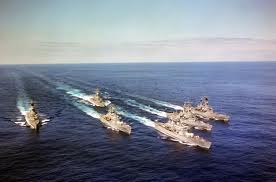
Galvanic corrosion is an issue that has challenged U.S. warships since 1844, when the USS Michigan, the first iron-hulled Navy ship, entered service. Today, two common and robust solutions, impressed current cathodic protection systems and the use of strategically-placed sacrificial anodes, are in wide use throughout the world, particularly in ships where two different metals such as steel and aluminum are utilised in the one vessel.
As a specialist in aluminum shipbuilding, having built over 220 aluminum vessels for defence forces and commercial clients around the world since its formation in 1988, Austal is intimately familiar with the management of galvanic corrosion. An electrochemical process, galvanic corrosion occurs when two dissimilar metals, after being in electrical contact with one another, corrode at different rates.
According to company records, galvanic corrosion has not been a factor on any Austal built and fully maintained vessel, and our technical experts are eager to support any request to identify root causes of any corrosion issue in any aluminum naval vessel in service today. The Westpac Express, an Austal-built and fully maintained high-speed catamaran, has shuttled U.S. Marines throughout the Pacific Basin continuously for ten years, with a 99.7% availability over that period.
As Prime Contractor for Jackson, the third Independence-variant Littoral Combat Ship (LCS-6), Austal has a well-developed methodology for the management of galvanic corrosion, which it has deployed globally on behalf of its defense and commercial clients. If selected to provide post-delivery support for the Littoral Combat Ship (LCS) Class Services program, it is a straight forward process for Austal engineers to regularly conduct systematic reviews of the electrical grounding throughout each Austal-built vessel to detect and eliminate stray currents that might cause electrolysis between the stainless steel impeller housing and of the adjacent aluminum structure.
An integral part of any post-delivery support program for a high-performance, high-speed vessel such as the Independence-variant LCS is to provide a cadre of qualified maintainers who can help our Navy partners to deploy temporary sacrificial anodes every time the vessel is moored, and ensure that high-voltage maintenance equipment is properly grounded before use aboard ship. These are services that Austal’s skilled aluminum specialists, operating from six maintenance hubs in the Asia-Pacific, North America, South America, Europe and the Middle East, offer Austal customers every day.
With almost 2,200 current employees at Austal’s USA shipyard, with a future workforce planned of over 4,000, each and every Austal employee is committed to making the Littoral Combat Ship a success. Awarded a ten-ship contract in December 2010, Austal has eagerly assumed the role of Prime Contractor for the Independence-variant Littoral Combat Ships awarded under the 10 ship block buy contract, and, as a Prime Contractor for those 10 ships, Austal will always stand by its products and our Navy partners.
We use cookies to improve your experience. By continuing to use our site, you accept our Cookies, Privacy Policy,Terms and Conditions. Close X